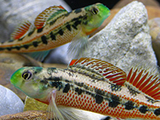The Science of Attraction
Biologist Tamra Mendelson explains how sexual selection plays a major role in the evolution of vibrant features, from stripes to tail feathers.
Male cardinals are red. Male peacocks have bright tail plumage. Conventional biological wisdom says that species look different because they are adapting to different environments — food, predators, or climate. That assumption is missing a major piece of the puzzle, say researchers at UMBC and the University of Colorado, Boulder.
In a recent study published in the journal Ecology Letters and featured in The Baltimore Sun, Tamra Mendelson and her co-authors suggest that sexual attraction plays a significant role in how animals — even those of the same species living in similar environments — can adapt different characteristics to attract mates. The researchers propose that animals don’t just respond to their environments, they respond to each other.
“It turns out males in particular don’t have to adapt to the environment,” says Mendelson, an associate professor of biological sciences at UMBC and lead author on the study. “They’re adapting to the opposite sex.”
This implies, says Mendelson, that populations in similar environments may come up with different ways to solve the same problem. For example, males in one population might evolve a flashy feather to attract females, whereas males in another population might evolve a colorful beak.
This helps explain the wide array of vivid colors and arresting features we finding in creatures like birds-of-paradise. It also highlights the point that just because two individuals don’t look the same or act the same, doesn’t mean they’re not the same species.
The next steps will involve testing the model, Mendelson explains. She will do experiments called reciprocal transplants: placing species A in the habitat of species B, and species B in the habitat of species A. According to Mendelson’s model there shouldn’t be any difference in how the males perform in their reversed habitats.
Next, Mendelson and her colleagues will do a reciprocal transplant of the sexual environment. This involves allowing males of species A to compete with each other for females of species B and vice versa.
Mendelson says, “I want to understand why and what ornaments are going to be particularly attractive.” She hopes this will help scientists understand the development of such varied and complex ornamentation.
“What kind of a mutation would be successful?” Mendelson asks. “Mutations drive evolution. You could argue that it is mutation that is the most important thing. What is it about the female fish brain that makes certain male ornamentation more attractive?”
Mendelson and Natalie Roberts, PhD student in biological sciences, will use video animations of darter fish to ask that question in their ongoing research. Amazingly, fish respond readily to video images of other fish, so the researchers will manipulate videos of male darters to see if and how they can make them more attractive to fish of the opposite sex.
“We can use the videos to create mutations that don’t exist yet, to see what could happen in the future," says Mendelson.
Will an extra fin stripe or spot of color make a fish more attractive? Only the TV-watching darters can tell us.
Tags:
Posted: February 11, 2015, 10:08 PM
